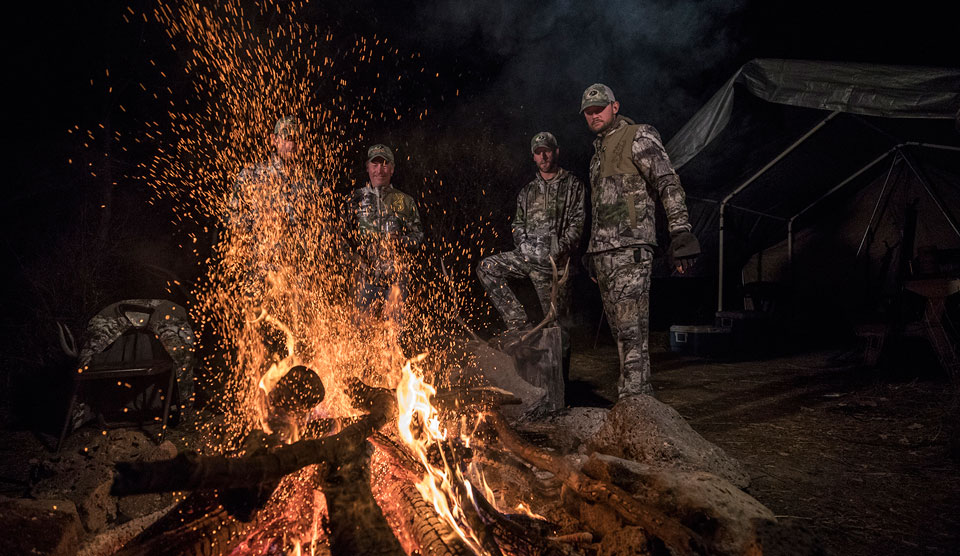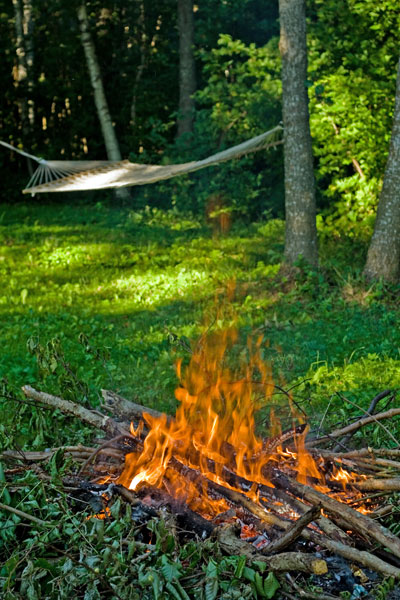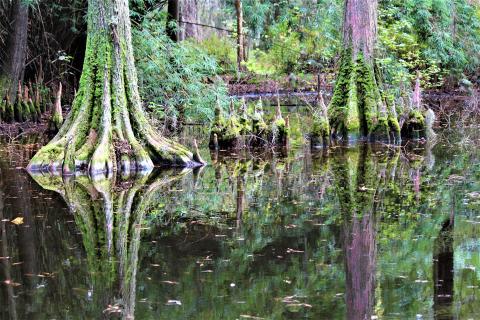Inclement weather is one of the most common instigators of potentially life-threatening situations for outdoors enthusiasts. Sure, a little rain on your hike is nothing to write home about, but what if a big storm hits when you’re too deep in the backcountry to get out safely? What if you fall into a wetland tracking a buck on a day when the temperature is topping out at 40° F? Now you’re wet, cold and miserable, and the risk of hypothermia is increasing with every minute you’re not warming yourself up and drying out.
A fire can save your life, but can you start one in the rain if you had to? Keeping these survival tips in mind can mean the difference between having an awesome story to impress your friends with or being the poster child for what not to do in a dangerous situation.

Location, Location, Location
Assuming you haven’t incapacitated yourself and can move around, look for a spot sheltered from the wind and rain to set your fire. A cave, against a rock face, under an overhang or a sheltered stand of trees (make sure the canopy is at least 5 to 6 feet above you) are good options. Not only can this barrier protect your fire, it also helps you feel more comfortable and speed up your warming and drying. If shelter is nowhere to be found, you might be able to construct a rough lean-to out of limbs and boughs or dig a pit as deep as you can to shield your fire.
Once you find a suitable location, you can focus on finding fuel and building your fire.
Finding Fuel
Fire needs fuel–dry fuel–which can be difficult to find in wet weather if you don’t know where to look. You need tinder and a range of fuel wood sizes, from pencil-sized sticks to larger branches and pieces of wood.
Anything fibrous should do for tinder, but some sure-fire (pun intended) sources include milkweed or cattail fluff, shredded cambium (the tree layer just under the bark), pine needles, grasses and leaves. The transition zone between forest and field or wetland is a good place to look for tinder due to the diverse array of plant species. Dig around under the herbaceous layer on the ground to find dry grasses and leaves, and break open intact milkweed pods or cattails for the driest fluff.
Don’t skimp on the tinder–you’ll want to have a backup supply in case you have trouble getting the fire going or you need to relight it later. Tuck your collected tinder inside your clothes to keep it dry until you’re ready to build your fire. If you’re a planner, you can pack some emergency tinder to carry with you just in case. Dryer lint, Vaseline-soaked cotton balls and beeswax-coated pine cones all work well and can store for months or even longer.
 While you may be tempted to grab those fallen sticks and branches you see lying on the ground all around you, they’re probably too wet to be of any use to you. Instead, look for large pine trees with ground-sweeping boughs. The area under these boughs can be a treasure-trove of dry, resin-coated branches and needles. Conifer resin (sap) is highly flammable and makes a fantastic fire starter.
While you may be tempted to grab those fallen sticks and branches you see lying on the ground all around you, they’re probably too wet to be of any use to you. Instead, look for large pine trees with ground-sweeping boughs. The area under these boughs can be a treasure-trove of dry, resin-coated branches and needles. Conifer resin (sap) is highly flammable and makes a fantastic fire starter.
Another potential source of dry fuel is the dead lower branches of still-standing trees that have been protected from moisture by the limbs above. If their surface is wet, use a knife to scrape down into the dry wood inside. Branches and bark on the underside of fallen trees may also be dry enough to use.
Collect more fuel than you think you need. You may be loath to leave your fire once you’ve gotten it started, and you don’t know how long you have to keep it going. Store your extra fuel up off the damp ground (in the crotch of a tree, for example) and protect it from the rain until you need it. If you can’t get it off the ground or cover it, pile it close enough to your fire to help keep it dry.
If You Build It
Build your fire in a way that maximizes air flow and fuel ignition. A teepee structure on top of a twig platform works well for this.
First, use some of the smaller branches you have collected to construct a platform on the ground–think Huck Finn’s raft in miniature. This gets your fire off the wet ground, increases air flow and contributes to the coal bed. This is especially important if you haven’t found a sheltered location and are building your fire in a pit, since the platform keeps your fire above any water that might run into the pit.
Next, build a teepee around a loose ball of tinder material by leaning twigs and branches against each other vertically. Build outward with successively larger fuel wood. This structure creates a chimney to channel the flames and heat upward, which speeds up ignition.
Size Matters
Keep your fire small. Although it may be tempting to build a large fire when you’re cold and wet, you can physically get closer to a smaller fire and it won’t consume your hard-won fuel as quickly. Aim for a fire no taller than mid-shin.
Come on, Baby, Light (Your) Fire
Lighting the fire should be the easy part if you’ve built it well. Waterproof matches, a windproof lighter or a sparking device all work and should be a permanent fixture in your pack. Otherwise, you might want to brush up on your bow drill skills.
Light the tinder at the base of the teepee on the windward side, blowing gently to fan the flames if necessary. Once the teepee catches, add more fuel, but be careful not to collapse the structure.
Practice Makes Perfect
Most of us don’t intend to be stuck outdoors in miserable weather, but planning for that eventuality is never a bad idea. An even better idea is practicing the skills when the circumstances aren’t life-threatening, so you can be confident in your abilities when they are. Go ahead, give it a try on your next outdoor adventure!






























